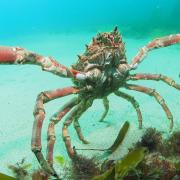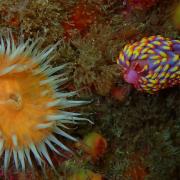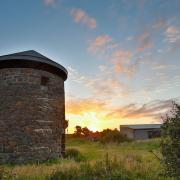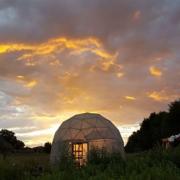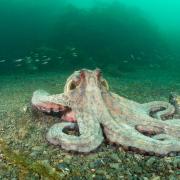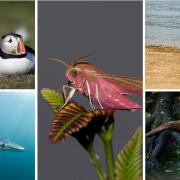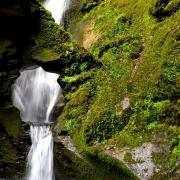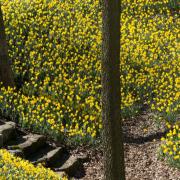Egrets are becoming more common in Cornwall and we look at ways to identify them in this February issue
Making a Mark
Egrets are becoming more common in Cornwall and David Chapman helps us identify them
One of the many attractions of being a bird watcher in Cornwall is that you never know quite what to expect next. We all know that the county gets more than its fair share of rare birds in autumn and spring from the Continent and even as far away as America and Asia, but one thing that seems to get less media coverage is the arrival of a new breeding species.
Being the most southerly county in Britain we are well placed to welcome new breeding species of bird. Prior to 1996 the little egret was unknown as a breeding bird in Britain and was still regarded very much as a rarity across the country. In that year the first pair bred on Brownsea Island in Dorset and then in 1997 Cornwall saw its first breeding pair on the River Helford. Since then the little egret has become a familiar sight to anyone with an interest in the wildlife of Cornwall.
Last winter saw a massive influx of one of the little egret's closest relatives, the cattle egret. Prior to this unprecedented event, fewer than 100 cattle egrets had been recorded in Britain in the last 50 years but during last winter and early spring we had somewhere in the region of 40 birds in West Penwith alone. So, is the cattle egret the next little egret? Well, last summer a pair bred in Somerset so maybe this year there may be more breeding success.
LITTLE EGRET
The little egret stands at a maximum of about 60cm tall with a wingspan of about 1m, which is significantly smaller than the better-known grey heron. Its plumage is white but it does have beautiful plumes from its neck and body during the breeding season. It has a dagger-shaped black bill with bluish-grey skin colouring between the eye and bill; its eyes are yellow with a black pupil and this colour combination is repeated on its legs. The little egret's feet are quite striking because although its legs are black, its feet are yellow, a fact which can only really be seen when the egret is flying past or standing.
The little egret is most often seen on estuaries, creeks and the shoreline, though, as its range spreads, it is taking to freshwater marshes, rivers and lakes more frequently. It is an active feeder, quickly moving in pursuit of prey often circling a spot before lashing into the centre to catch a small fish. I have even watched little egrets following cormorants along a creek, presumably hoping that they might disturb fish for the egret to catch; the optimum prey size for a little egret is about 4cm long.
The history of the little egret has been quite volatile in Europe. In the 19th and early 20th centuries little egrets were hunted for their attractive plumes across the continent, so their population was hit badly. The First World War put an end to this hunting and the birds began to re-establish breeding populations in southern Europe. By 1960 little egrets were breeding in northern France and were widespread again there by the 1980s. The first breeding record in Britain was in 1996 and in Cornwall was in 1997; since then breeding has been increasing slowly. Generally, little egrets nest amongst grey herons making similar nests high in the trees.
One element of their behaviour which has helped the egret establish itself quite quickly in more northerly climes is its post-breeding dispersal. Unlike most birds, little egrets habitually move northwards after breeding, along with their young, and often stay there to overwinter. For this reason we see more little egrets in Cornwall during autumn and winter than at any other time of year and the milder winters experienced of late have helped the little egret become a familiar bird in the county.
CATTLE EGRET
The cattle egret stands about 40cm tall and with a wingspan of about 90cm it is smaller than the little egret. Its plumage during winter is pure white. It differs from the little egret in that it has plain greyish-green legs and a yellowish-green bill. Later in spring the cattle egret develops a rather attractive buff plumage on its crest, neck and back making this a very distinctive and beautiful bird.
A good way to distinguish the cattle egret is to consider its profile. The little egret is a slender bird with long legs and slim neck whilst the cattle egret has a shorter-legged, hunched form with neck bent into an almost invisible 's' shape, its head almost on its shoulders.
The name of the cattle egret provides us with a useful tip for locating this bird. Unlike the heron and little egret, which spend most of their feeding time in waterways, the cattle egret feeds by following domesticated animals and catching the insects that they disturb - grasshoppers are a favourite. Generally the habitat for these two birds is different but don't make the assumption that little egrets don't stand in fields with cattle, or that you will never get a cattle egret on an estuary! Identification cannot be clinched by habitat alone.
Around the world cattle egrets are quite common, being found in Australia, Asia, Africa, southern Europe and America. Until last year they had never bred in Britain, the nearest breeding colonies being in southern Spain and France. Their spread into a new breeding area by first starting with a mass influx is not without precedent, in the early part of the 20th century they were unknown in America.
Last winter may be a precedent for the eventual spread of cattle egrets across the country. If it is, then I suspect that many people will offer global warming as a cause but what is more critical in their success is their ability to thrive in close association with humans, something that they clearly do all over the world.
Last January I spotted a group of five cattle egrets feeding in fields near Trencrom Hill in Penwith. I found a field full of cattle so thought it was worth a look. To my dismay there weren't any cattle egrets with the cattle but on checking a neighbouring field containing sheep I found the five cattle egrets there. Fortunately there isn't a species called the 'sheep egret' so I was fairly sure I was watching the right thing!
In the field where I watched the cattle egrets they were associating with gulls. Their pure white plumage and chicken-like walk made them easily identifiable from their companions. Occasionally all the birds would take off simultaneously and then the broad, arched wings of the cattle egret gave them a graceful, calm appearance unlike the frenzied flapping of the gulls' wings.
Its always exciting to see something new and spotting cattle egrets in Cornwall was certainly that. I reckon we will see more of this graceful bird.
WHERE TO SEE EGRETS
Little egrets can best be watched on estuaries. I have had my closest views at Lerryn near Lostwithiel where a group of them wander about within about ten yards of the car park on the creek side. For sheer number it is difficult to beat the Camel Estuary around Little Petherick Creek, while for the romantics out there it is difficult to beat the atmosphere of Frenchman's Creek near Helford.
It is difficult to predict exactly what is going to happen with cattle egrets. Last year the best places were all in West Penwith with fields around Drift Reservoir attracting the majority of birds but this year it could be somewhere completely different, if they appear at all.
To optimise your chances of seeing them check any fields where cattle or other livestock are grazing. Or have a look at the Cornwall Birding website for the latest day-by-day reports, www.cornwall-birding.co.uk.









